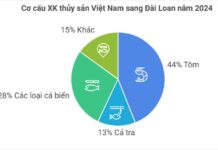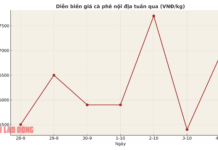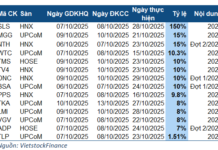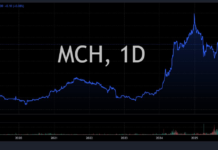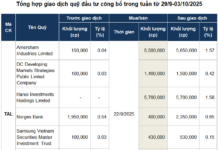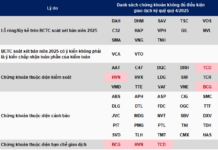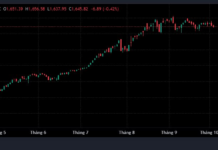Exchange Rate Continuously Increasing
On April 17, the SBV announced the central exchange rate at 24,231 VND/USD, an increase of 90 VND compared to yesterday. Thus, in just 2 days, the central exchange rate has increased by 135 VND/USD and is the highest level in the past year. With a +/-5% margin, commercial banks are allowed to set the highest selling price of USD at 25,442 – 25,443 VND/USD, the lowest is 23,019 VND/USD.
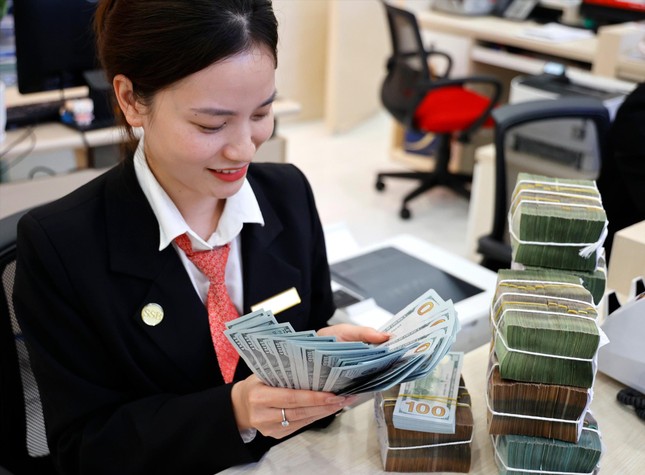
Bank USD exchange rate hits new high above 25,400 VND/USD. Photo: As Ý.
At many banks, the USD price today is raised to the ceiling. The bank VietinBank lists the USD selling price at 25,105 – 25,443 VND/USD buying – selling. Bank ACB also lists the selling price of USD at the ceiling price of 25,160 – 25,442 VND/USD buying – selling. Meanwhile, three other major banks, Vietcombank, Eximbank, BIDV raised the selling price of USD to the ceiling: 25,440 VND/USD. The purchase price fluctuates from 25,040 – 25,130 VND/USD. Since the beginning of the year, each USD in the bank has increased by more than 1,000 VND, equivalent to nearly 5%.
In the free market, the USD price continues to rise. The free USD price is commonly traded around the level of 25,520-25,670 VND/USD buying – selling. Compared to the previous session, the free USD price increased by 50 VND in the buying direction and increased by 70 VND in the selling direction. The difference between the USD price on the free market and the bank has narrowed. Currently, the buying price of USD in the free market is about 300-400 VND/USD higher than that of commercial banks. The selling price is more expensive than the bank by about VND 200/USD.
Since the beginning of the year, the exchange rate has continuously fluctuated upward. In that context, since the beginning of March, the SBV has continuously issued treasury bills to absorb liquidity from commercial banks, helping to prevent banks from buying USD for profit. This move helps reduce pressure on the exchange rate.
However, according to the analysis of KB Vietnam Securities Company (KBSV), the SBV’s issuance of treasury bills to regulate the market has not been as effective as expected.
Will the SBV sell foreign currencies to intervene?
Foreign exchange reserves have always been considered the “trump card” to stabilize the exchange rate and have been enhanced by the SBV for many years. The latest data released by the SBV shows that the size of foreign exchange reserves reached over USD 109.9 billion at the end of 2021, 10 times higher than the foreign exchange reserves recorded in 2010 and nearly 4 times higher than in 2015.
However, after reaching a record high in the first quarter of 2022, foreign exchange reserves fell sharply in 2022 as the SBV had to sell a large amount of foreign currencies to stabilize the exchange rate.
After selling a large amount of foreign currencies to stabilize the exchange rate, from the beginning of 2023, the SBV began to buy foreign currencies again as the exchange rate in the country reversed. At the regular Government Meeting on May 5, 2023, SBV Governor Nguyen Thi Hong said that the agency has purchased about USD 6 billion since the beginning of 2023. Although there are no latest statistics on foreign exchange reserves at this time, according to The estimates of international organizations as well as market analysis companies show that Vietnam’s foreign exchange reserves are at a high level.
At the workshop on ” Financial Markets Vietnam 2023 and Prospects for 2024″ organized by the Joint Stock Commercial Bank for Investment and Development of Vietnam (BIDV), the Asian Development Bank (ADB) and the National Financial Supervision Commission (NFSC) on April 16, Assoc. Can Van Luc, BIDV’s chief economist said that recent exchange rate fluctuations are mainly due to the appreciation of the USD. Since the beginning of the year, the USD has risen by 4.5%. The USD is up for 2 reasons: First, the Fed seems hesitant to cut rates, and second, the US economy is not in recession and is recovering better than last year. This has caused the USD to appreciate and domestic currencies pegged to the USD have all depreciated over the past period.
“Basically, the supply and demand for foreign currency in Vietnam is still stable. When the Fed starts to cut interest rates, possibly from the third quarter, the exchange rate will immediately relieve pressure,” said Mr. Luc.
In response to the question of whether the SBV could sell foreign currencies, Mr. Luc said that the SBV would have to calculate carefully, as it is also related to the import of gold. If the foreign exchange market fluctuates strongly, the SBV will also be ready to intervene, using various resources.
Experts also recognize that the SBV is likely to take appropriate measures, including the possibility of selling foreign exchange interventions.



